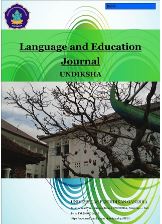Affixation of Taro Dialect: A Descriptive Study
DOI:
https://doi.org/10.23887/leju.v1i1.20241Abstract
This descriptive study aimed at describing the number of prefixes and suffixes in Taro Dialect and its types of inflectional and derivational. This study is a descriptive qualitative research. Two informant samples of Taro Dialect were chosen based on a set of criteria. The data were collected based on three techniques, namely; observation, recording technique, and interview (listening and noting) technique. The results of the study show that there were five prefixes and five suffixes existing in Taro Dialect. The prefixes were {N-}, {ma-}, {sa-}, {pa-}, and {ka-}. The suffixes were {-in}, {-ne}, {-an}, {-ang}, and {-e}. The prefixes and suffixes that belong to derivation are: prefix {N-}, {ma-}, {sa-}, {pa}, and {ka-} and suffix {-ang}, {an}, {-ne}, and {-in}. The prefixes and suffixes that belong to inflection are: prefixes {N-}, {ma-}, and {ka-} and suffix {-ang}, {an}, {-ne}, {-in}, and {-e}.Downloads
Published
2018-02-02
How to Cite
Artawan, K. (2018). Affixation of Taro Dialect: A Descriptive Study. Language and Education Journal Undiksha, 1(1). https://doi.org/10.23887/leju.v1i1.20241
Issue
Section
Articles










